The Spatial Analysis of Regional Innovation Performance and Industry-University-Research Institution Collaborative Innovation—An Empirical Study of Chinese Provincial Data
Abstract
1. Introduction
2. Literature Review
2.1. IUR Interaction and Collaborative Innovation
2.2. Regional Innovation Performance and Absorptive Capacity
2.3. Spatial Correlation and Spatial Econometrics
3. Model Construction and Measure Methods
3.1. The Construction of Spatial Econometric Model
3.2. The Measure of Regional Innovation Performance
3.3. The Measure of Synergy Degree of IUR Collaborative Innovation System
3.4. The Measurement of Spatial Correlation
4. Descriptive Analysis and Data Test
4.1. Descriptive Analysis of Key Indicators
4.1.1. Descriptive Analysis of Regional Innovation Performance
4.1.2. Descriptive Analysis of Synergy Degree
4.2. Spatial Correlation Test and Unit Root Test
5. Results and Discussion
5.1. The Results of Static Panel Data Spatial Econometric Model
5.2. The Results of Dynamic Panel Data Spatial Econometric Model
6. Conclusions and Recommendations
Acknowledgments
Author Contributions
Conflicts of Interest
References
- The Central People’s Government of the People’s Republic of China. The Guideline on Strengthening the Core Status of Enterprise Technology Innovation and Improve Enterprise Innovation Ability Comprehensively. Available online: http://www.gov.cn/zwgk/2013-02/04/content_2326419.htm (accessed on 6 April 2018).
- Bonaccorsi, A.; Piccaluga, A. A theoretical framework for the evaluation of university-industry relationships. R D Manag. 1994, 24, 229–247. [Google Scholar] [CrossRef]
- Perkmann, M.; Neely, A.; Walsh, K. How should firms evaluate success in university–industry alliances? A performance measurement system. R D Manag. 2011, 41, 202–216. [Google Scholar] [CrossRef]
- Pertuze, J.A.; Calder, E.S.; Greitzer, E.M.; Lucas, W.A. Best practices for industry-university collaboration. MIT Sloan Manag. Rev. 2010, 51, 83–90. [Google Scholar]
- Bolling, M.; Eriksson, Y. Collaboration with society: The future role of universities? Identifying challenges for evaluation. Res. Eval. 2016, 25, 209–218. [Google Scholar] [CrossRef]
- Bonaccorsi, A.; Colombo, M.G.; Guerini, M.; Rossi-Lamastra, C. University specialization and new firm creation across industries. Small Bus. Econ. 2013, 41, 837–863. [Google Scholar] [CrossRef]
- D’Este, P.; Iammarino, S. The spatial profile of university-business research partnerships. Papers Reg. Sci. 2010, 89, 335–350. [Google Scholar] [CrossRef]
- Muscio, A.; Nardone, G. The determinants of university-industry collaboration in food science in Italy. Food Policy 2012, 37, 710–718. [Google Scholar] [CrossRef]
- Bigliardi, B.; Galati, F.; Marolla, G.; Verbano, C. Factors affecting technology transfer offices’ performance in the Italian food context. Technol. Anal. Strateg. Manag. 2015, 27, 361–384. [Google Scholar] [CrossRef]
- Maietta, O.W. Determinants of university-firm R & D collaborative and its impact on impact on innovation: A perspective from a low-tech industry. Res. Policy 2015, 44, 1341–1359. [Google Scholar]
- Guan, J.; Liu, S. Comparing regional innovative capacities of PR China based on data analysis of the national patents. Int. J. Technol. Manag. 2005, 32, 225–245. [Google Scholar] [CrossRef]
- Wu, J.; Zhou, Z.X.; Liang, L. Measuring the performance of Chinese regional innovation systems with two-stage DEA-based model. Int. J. Sustain. Soc. 2010, 2, 85–99. [Google Scholar] [CrossRef]
- Guan, J. Measuring the Efficiency of China’s Regional Innovation Systems: Application of Network Data Envelopment Analysis (DEA). Reg. Stud. 2012, 46, 355–377. [Google Scholar]
- Aghion, P.; Howitt, P. On the Macroeconomic Effects of Major Technological Change. Ann. Decon. Stat. 1998, 3, 53–75. [Google Scholar] [CrossRef]
- Kim, C.S.; Inkpen, A.C. Cross-border R & D alliances, absorptive capacity and technology learning. J. Int. Manag. 2005, 11, 313–329. [Google Scholar]
- Maurer, I.; Bartsch, V.; Ebers, M. The Value of Intra-Organizational Social Capital: How It Fosters Knowledge Transfer, Innovation Performance, and Growth. Organ. Stud. 2011, 32, 157–185. [Google Scholar] [CrossRef]
- Mowery, D.C.; Sampat, B.N. Universities in National Innovation Systems; Oxford Handbook of Innovation; Oxford University Press: Oxford, MS, USA, 2005. [Google Scholar]
- Metcalfe, S.; Ramlogan, R. Innovation systems and the competitive process in developing economies. Q. Rev. Econ. Financ. 2008, 48, 433–446. [Google Scholar] [CrossRef]
- Cooke, P. Regional Innovation Systems: General Findings and Some New Evidence from Biotechnology Clusters. J. Technol. Transf. 2002, 27, 133–145. [Google Scholar] [CrossRef]
- Arvanitis, S.; Kubli, U.; Woerter, M. University-industry knowledge and technology transfer in Switzerland: What university scientists think about co-operation with private enterprises. Res. Policy 2008, 37, 1865–1883. [Google Scholar] [CrossRef]
- Bernard, A.; Jones, A. Technology and Convergence. Econ. J. R. Econ. Soc. 1995, 106, 1037–1044. [Google Scholar] [CrossRef]
- Kallio, A.; Harmaakorpi, V.; Pihkala, T. Absorptive capacity and social capital in regional innovation systems: The case of the Lahti region in Finland. Urban Stud. 2010, 47, 303–319. [Google Scholar] [CrossRef]
- Azagra-Caro, J.M.; Archontakis, F.; Gutierrez-Gracia, A.; Fernandex-de-Lucio, I. Faculty support for the objectives of university-industry relations versus degree of R & D cooperation: The importance of regional absorptive capacity. Res. Policy 2006, 35, 37–55. [Google Scholar]
- Lai, I.K.; Lu, T.W. How to improve the university-industry collaboration in Taiwan’s animation industry? Academic vs. industrial perpectives. Technol. Anal. Strateg. Manag. 2016, 28, 717–732. [Google Scholar] [CrossRef]
- Jung, J.; López-Bazo, E. Factor Accumulation, Externalities, and Absorptive Capacity in Regional Growth: Evidence from Europe. J. Reg. Sci. 2017, 57, 266–289. [Google Scholar] [CrossRef]
- Escribano, A.; Fosfuri, A.; Tribo, J.A. Managing external knowledge flows: The moderating role of absorptive capacity. Res. Policy 2009, 38, 96–105. [Google Scholar] [CrossRef]
- Miguélez, E.; Moreno, R. Knowledge flows and the absorptive capacity of regions. Res. Policy 2015, 44, 833–848. [Google Scholar] [CrossRef]
- Li, X. China’s regional innovation capacity in transition: An empirical approach. Res. Policy 2009, 38, 338–357. [Google Scholar] [CrossRef]
- Li, J.; Tan, Q.; Bai, J. Spatial Econometrics Analysis of China Regional Innovation Technology. Manag. World 2010, 7, 43–65. (In Chinese) [Google Scholar]
- Shi, X.; Zhao, S.; Wu, F. Analysis of Regional Innovation Efficiency and Spatial Discrepancy in China. J. Quant. Techn. Econ. 2009, 3, 45–55. (In Chinese) [Google Scholar]
- Zhang, Y.; Li, K. Research on the Spatial Dependence of Chinese Province-Level Innovation Output. Stud. Sci. Sci. 2008, 26, 659–665. (In Chinese) [Google Scholar]
- Li, J.; He, Y. Study of Knowledge Spillover Effect on Regional Innovation Performance from the Perspective of Spatial Correlation—Based on provincial Data Samples. R D Manag. 2017, 29, 42–54. (In Chinese) [Google Scholar]
- Bai, J.; Jiang, F. Synergy Innovation, Spatial Correlation and Regional Innovation Performance. Econ. Res. J. 2015, 7, 174–187. (In Chinese) [Google Scholar]
- Paelinck, J.; Klaassen, L. Spatial Econometrics; Saxon House: Farnborough, Hampshire, UK, 1979. [Google Scholar]
- Anselin, L.; Varga, A.; Acs, Z. Local Geographic Spillovers between University Research and High Technology Innovations. J. Urban Econ. 1997, 42, 422–448. [Google Scholar] [CrossRef]
- Anselin, L. Spatial Econometrics: Methods and Models; Kluwer Academic Publishers: Dordrecht, The Netherlands, 1988. [Google Scholar]
- Getis, A.; Griffith, D.A. Comparative Spatial Filtering in Regression Analysis. Geogr. Anal. 2002, 34, 130–140. [Google Scholar] [CrossRef]
- Fischer, M.M.; Varga, A. Spatial knowledge spillovers and university research: Evidence from Austria. Ann. Reg. Sci. 2003, 37, 303–322. [Google Scholar] [CrossRef]
- Smith, S.L.J. Tourism Analysis: A Handbook; Longman: Harlow, UK, 1989. [Google Scholar]
- Witt, S.F.; Witt, C.A. Forecasting tourism demand: A review of empirical research. Int. J. Forecast. 1995, 11, 447–475. [Google Scholar] [CrossRef]
- Roy, J.R.; Thill, J.C. Spatial Interaction Modelling; Springer: Heidelberg/Berlin, Germany, 2004. [Google Scholar]
- Levin, A.; Lin, C.F.; Chu, C.S.J. Unit root tests in panel data: Asymptotic and finite-sample properties. J. Econom. 2002, 108, 1–24. [Google Scholar] [CrossRef]
- Elhorst, J.P. Specification and Estimation of Spatial Panel Data Models. Int. Reg. Sci. Rev. 2003, 26, 244–268. [Google Scholar] [CrossRef]
- Anselin, L.; Bera, A.K.; Florax, R.; Yoon, M.J. Simple diagnostic tests for spatial dependence. Reg. Sci. Urban Econ. 1996, 26, 77–104. [Google Scholar] [CrossRef]
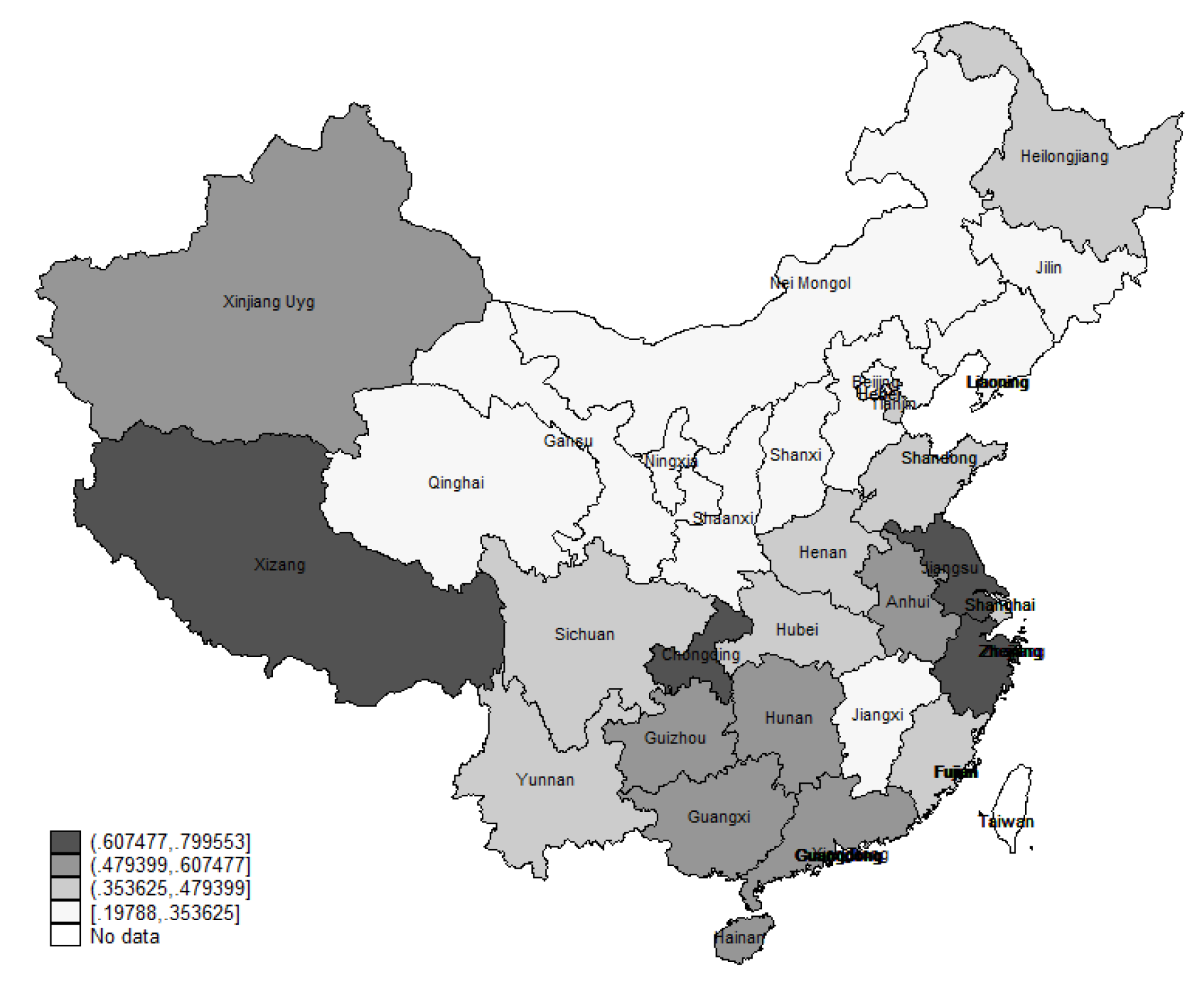
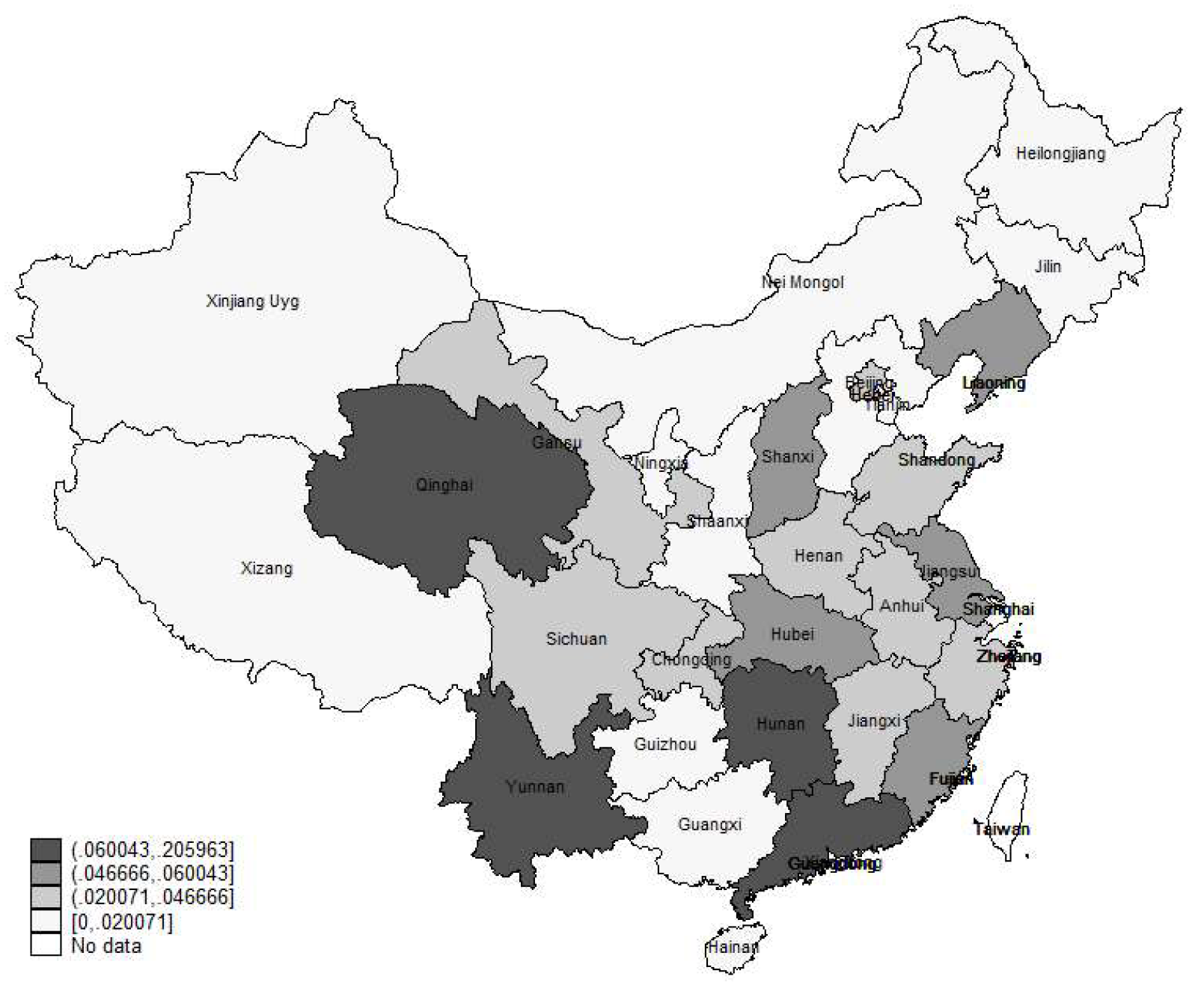
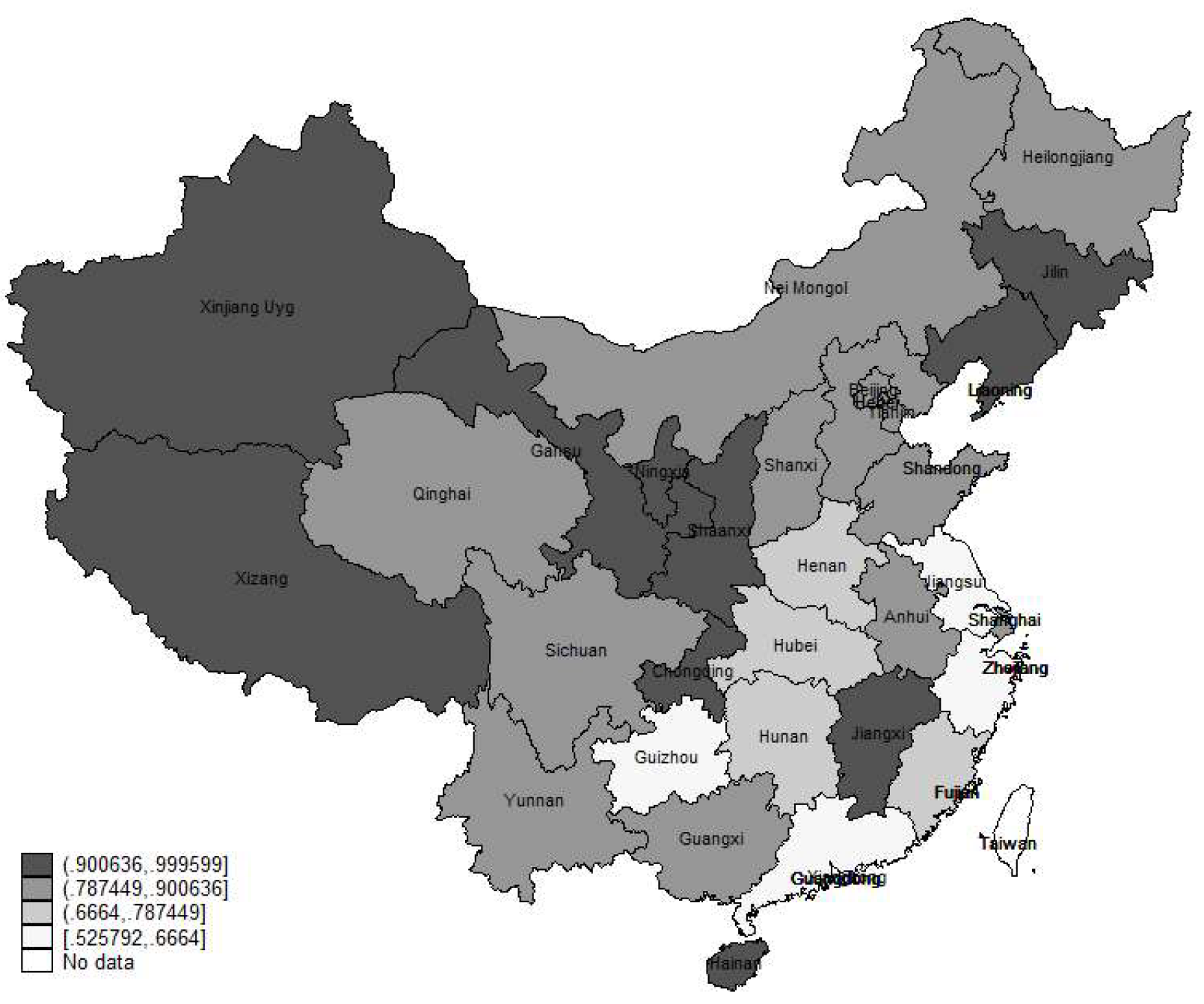
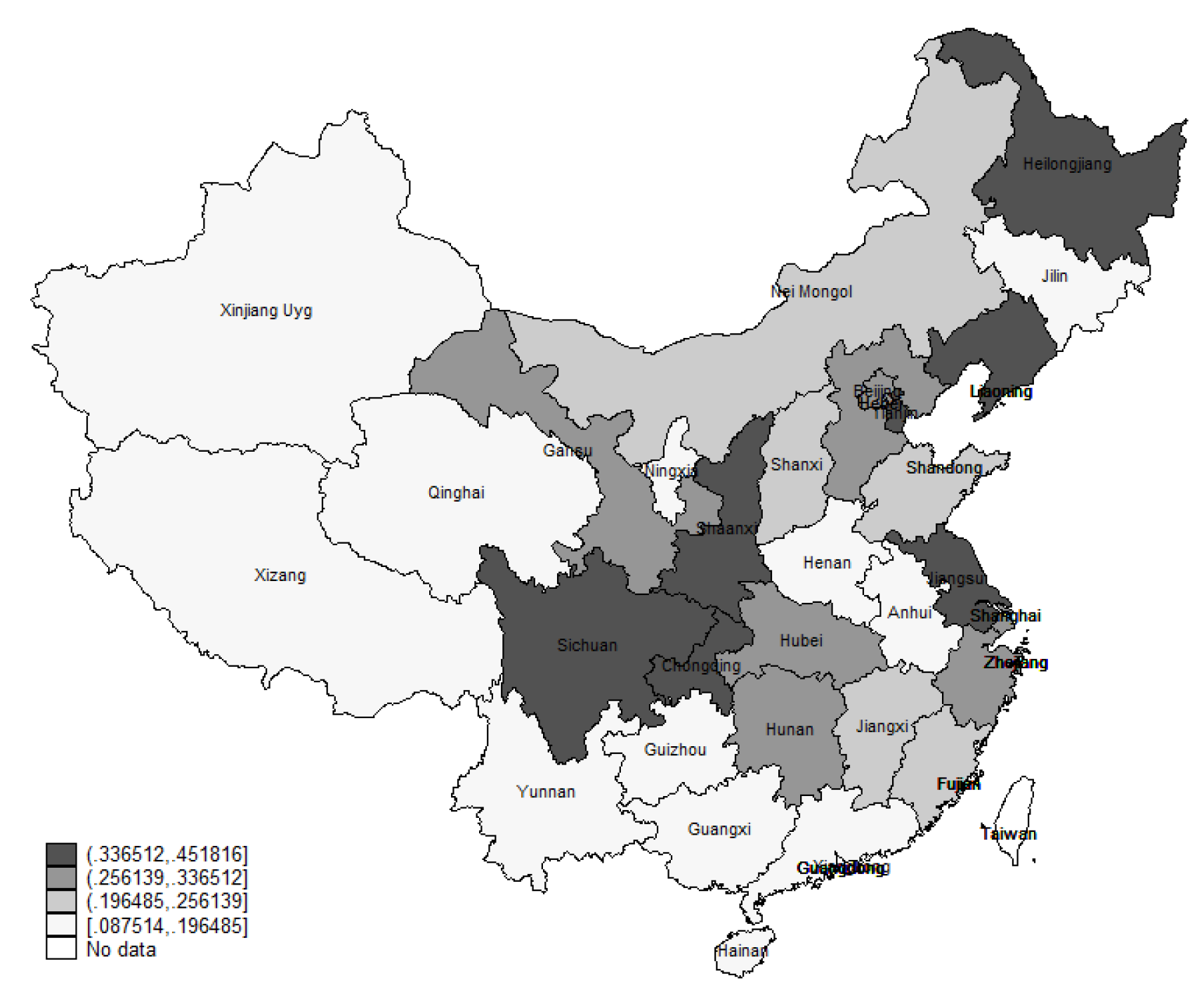
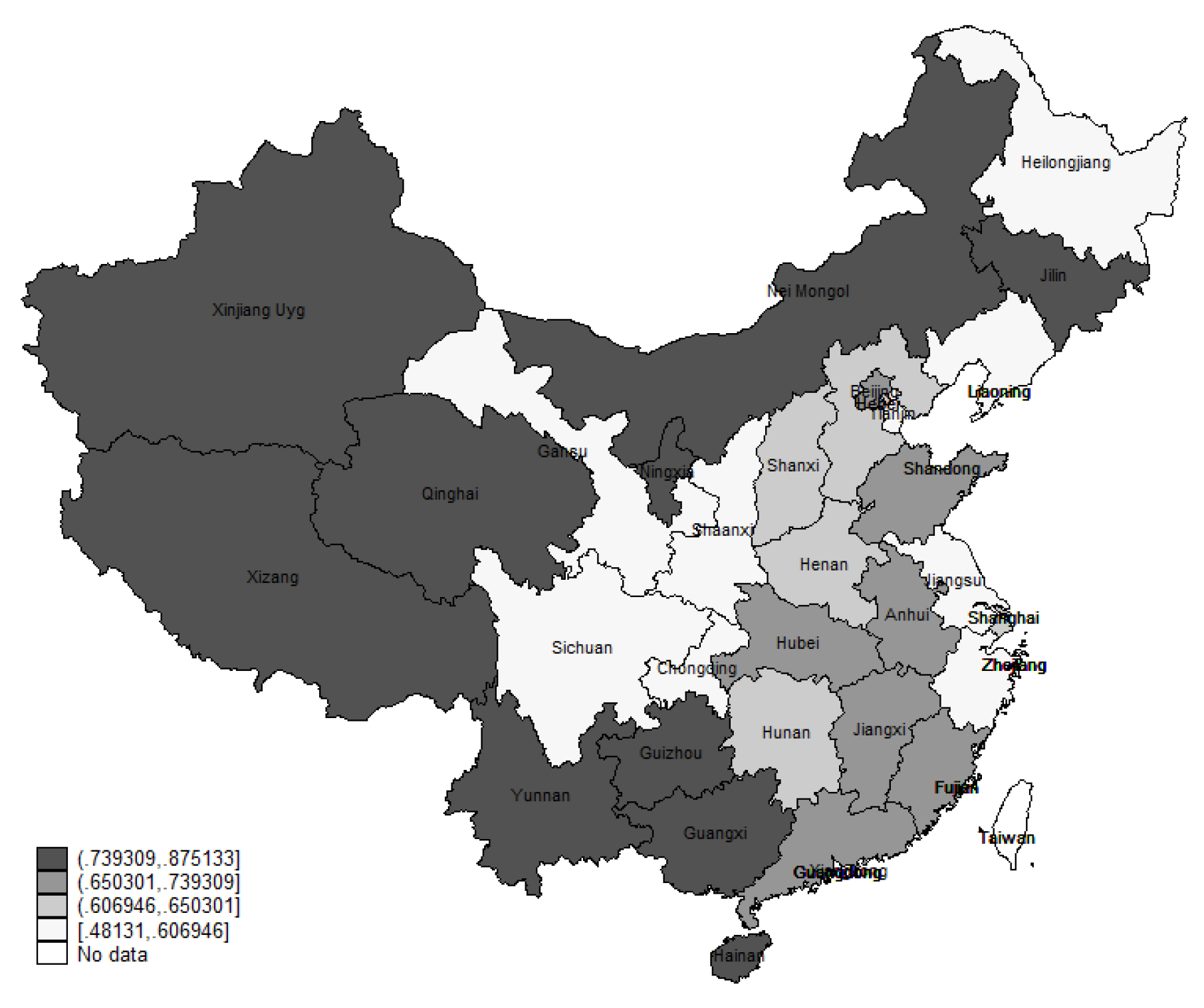
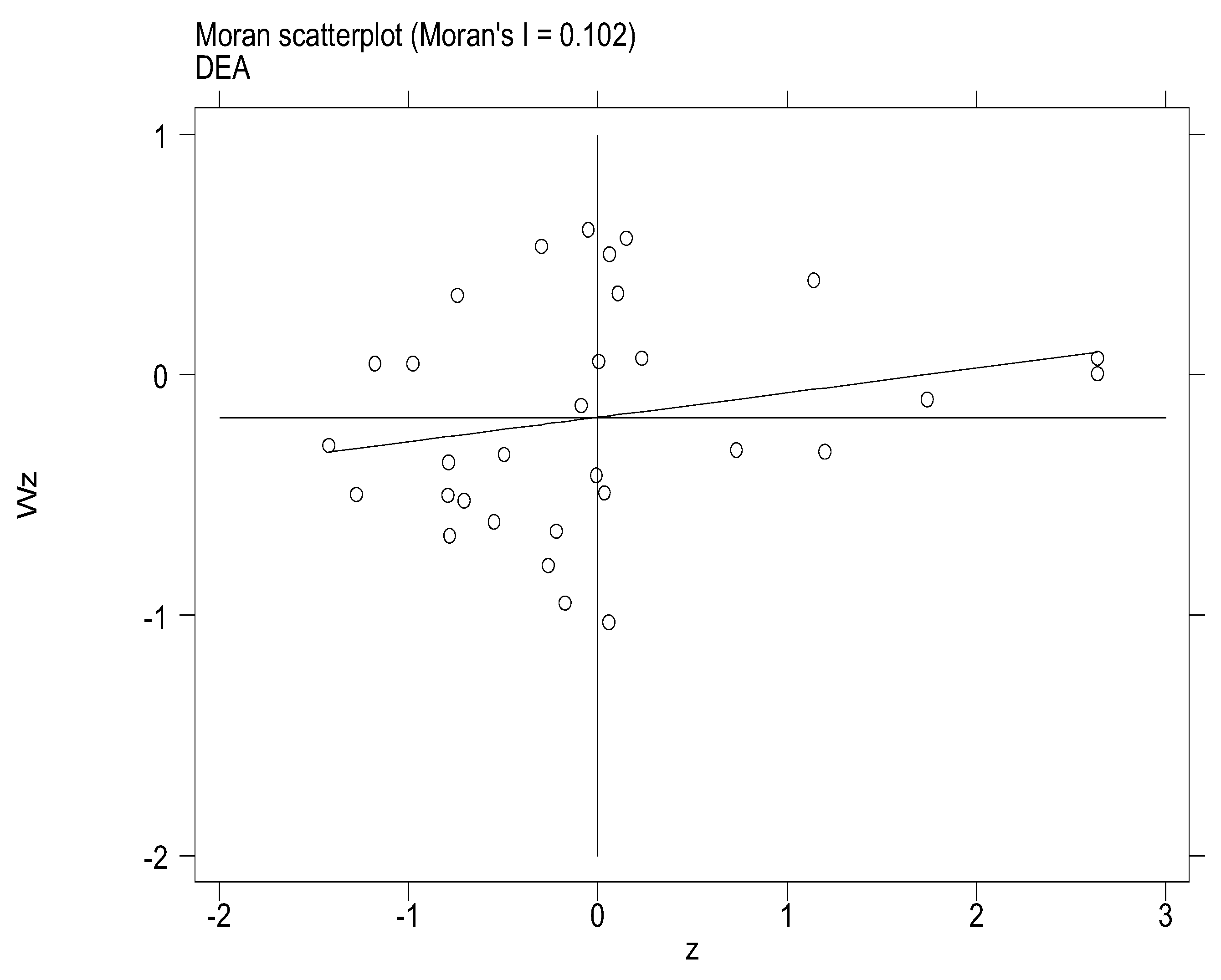
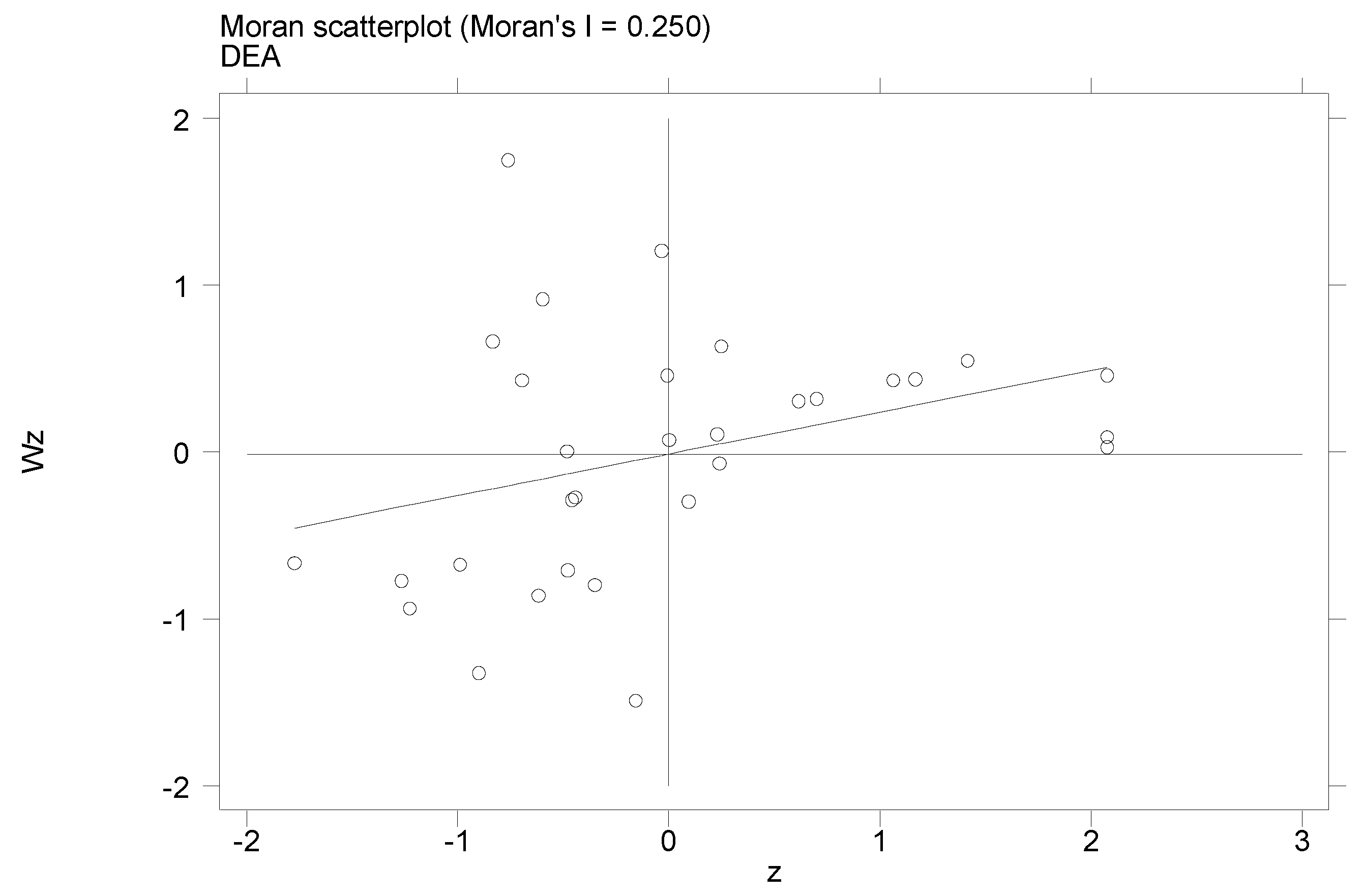
| Year | 2006 | 2007 | 2008 | 2009 | 2010 | 2011 | 2012 | 2013 | 2014 | 2015 |
|---|---|---|---|---|---|---|---|---|---|---|
| Moran’s I | 0.09 | 0.14 ** | 0.11 * | 0.15 ** | 0.28 *** | 0.21 *** | 0.28 *** | 0.29 *** | 0.29 *** | 0.29 *** |
| Geary’s C | 0.67 ** | 0.68 ** | 0.74 * | 1.03 | 0.83 | 0.82 | 0.78 | 0.73 ** | 0.76 * | 0.78 * |
| Variables | lnGDPP | lnPOP | lnRDP | lnRDC | lnPat | GR | IR | GU | IU | |
|---|---|---|---|---|---|---|---|---|---|---|
| t-value | −15.69 | −7.03 | −8.69 | −14.14 | −9.88 | −10.10 | −9.75 | −14.10 | −9.06 | −10.46 |
| p > t | 0.00 | 0.00 | 0.00 | 0.00 | 0.00 | 0.00 | 0.00 | 0.00 | 0.00 | 0.00 |
| Results | Stable | Stable | Stable | Stable | Stable | Stable | Stable | Stable | Stable | Stable |
| Variables | R&D Capital Weight Matrix | R&D Personnel Weight Matrix | ||||
|---|---|---|---|---|---|---|
| MLE-SAR | MLE-SAR-FE | GMM | MLE-SAR | MLE-SAR-FE | GMM | |
| 0.0003 *** (0.0000) | 0.0003 *** (0.0000) | - | 0.0002 *** (0.000) | 0.0002 *** (0.0000) | - | |
| GR | −0.1659 *** (0.0634) | −0.1438 * (0.0774) | −0.1426 * (0.0794) | −0.1342 ** (0.0598) | −0.0938 (0.0728) | −0.1577 ** (0.0800) |
| L.GR | 0.0173 (0.0800) | −0.0541 (0.0830) | - | −0.0188 (0.0751) | −0.0338 (0.0839) | |
| IR | −0.1180 (0.1518) | −0.3224 ** (0.1644) | −0.3752 ** (0.1745) | −0.1575 (0.1424) | −0.3505 ** (0.1536) | −0.3723 ** (0.1745) |
| L.IR | - | 0.4672 *** (0.1701) | 0.3360 * (0.1763) | - | 0.4173 *** (0.1590) | 0.4382 ** (0.1777) |
| GU | −0.1669 (0.1375) | −0.1421 (0.1538) | 0.0931 (0.1600) | −0.0762 (0.1265) | −0.0765 (0.1429) | 0.0961 (0.1585) |
| L.GU | - | −0.0362 (0.1602) | 0.1242 (0.1608) | - | 0.0088 (0.1487) | 0.1165 (0.1593) |
| IU | −0.1099 (0.1310) | −0.2183 (0.1587) | 0.0230 (0.1678) | 0.0179 (0.1212) | −0.1314 (0.1483) | 0.0057 (0.1698) |
| L.IU | - | 0.1407 (0.1648) | 0.3333 ** (0.1652) | - | 0.2096 (0.1528) | 0.3520 ** (0.1652) |
| lnGDPP | 0.1854 *** (0.06312) | 0.1946 *** (0.0624) | 0.1897 *** (0.0731) | 0.1276 *** (0.0590) | 0.1429 *** (0.0581) | 0.2055 *** (0.0739) |
| lnPOP | 0.1216 *** (0.0456) | 0.1202 *** (0.0447) | −0.0237 *** (0.0492) | 0.0514 (0.0390) | 0.0526 (0.0383) | −0.0162 (0.0500) |
| lnRDP | −0.1873 *** (0.0585) | −0.1765 *** (0.0584) | −0.1473 *** (0.0616) | −0.2741 *** (0.0568) | −0.2698 *** (0.0565) | −0.1286 ** (0.0612) |
| lnRDC | −0.8792 *** (0.0651) | −0.8917 *** (0.0641) | −0.8221 *** (0.0706) | −0.7126 *** (0.0633) | −0.7203 *** (0.0619) | −0.8277 *** (0.0692) |
| lnPat | 0.8555 *** (0.0303) | 0.8538 *** (0.0304) | 0.8869 *** (0.0352) | 0.7928 *** (0.0301) | 0.7888 *** (0.0301) | 0.8783 *** (0.0355) |
| constant | 0.0737 (0.2869) | 0.0170 (0.2972) | 0.2308 (0.3506) | 0.3857 (0.2656) | 0.3109 (0.2761) | 0.1531 (0.3581) |
| Adjust R2 | 0.5952 | 0.5985 | 0.7404 | 0.5246 | 0.5235 | 0.7387 |
| Variables | R&D Capital Weight Matrix | R&D Personnel Weight Matrix | ||||
|---|---|---|---|---|---|---|
| SAR | SAR | SAR-FE | SAR | SAR | SAR-FE | |
| 0.0003 ** (0.0001) | 0.0004 ** (0.0002) | 0.0003 (0.0002) | 0.0002 *** (0.0001) | 0.0003 *** (0.0001) | 0.0002 (0.0001) | |
| L.DEA | 0.9344 *** (0.2170) | 0.8114 *** (0.1389) | 0.8430 *** (0.1686) | 0.9261 *** (0.2132) | 0.7750 *** (0.1251) | 0.8065 *** (0.1387) |
| GR | −0.0344 (0.0624) | −0.0116 (0.0657) | 0.0082 (0.0704) | −0.0237 (0.0614) | −0.0045 (0.0654) | 0.0015 (0.0707) |
| L.GR | - | −0.0230 (0.0631) | 0.0037 (0.0678) | −0.0144 (0.0631) | 0.0009 (0.0679) | |
| IR | −0.2698 ** (0.1244) | −0.1455 (0.1344) | −0.1522 (0.1442) | −0.2590 ** (0.1226) | −0.1554 (0.1338) | −0.1406 (0.1440) |
| L.IR | - | 0.3059 ** (0.1319) | 0.2974 ** (0.1401) | 0.2988 ** (0.1312) | 0.3011 ** (0.1400) | |
| GU | −0.3173 *** (0.1235) | −0.2542 ** (0.1286) | −0.3085 ** (0.1431) | −0.3113 ** (0.1217) | −0.2500 * (0.1282) | −0.2661 * (0.1422) |
| L.GU | −0.0832 (0.1287) | −0.0983 (0.1389) | −0.0592 (0.1276) | −0.0905 (0.1392) | ||
| IU | −0.3958 *** (0.1379) | −0.3224 ** (0.1470) | −0.3965 ** (0.1581) | −0.3650 *** (0.1350) | −0.3149 ** (0.1460) | −0.3654 ** (0.1597) |
| L.IU | −0.0135 (0.1360) | −0.0509 (0.1484) | 0.0172 (0.1344) | −0.0373 (0.1487) | ||
| lnGDPP | 0.3167 * (0.1722) | 0.0069 (0.2122) | 0.1913 (0.2371) | 0.2885 * (0.1616) | 0.0998 (0.2122) | 0.0468 (0.2590) |
| lnPOP | 0.3303 ** (0.1320) | 0.7345 *** (0.2831) | 0.6061 (0.9654) | 0.2438 ** (0.1158) | 0.4718 ** (0.2255) | 0.5463 (0.9710) |
| lnRDP | −0.4821 *** (0.0466) | −0.4846 *** (0.0459) | −0.4957 *** (0.0491) | −0.4918 *** (0.0462) | −0.4864 *** (0.0459) | −0.4986 *** (0.0491) |
| lnRDC | −0.5451 *** (0.0963) | −0.6030 *** (0.1104) | −0.5473 *** (0.1297) | −0.5103 *** (0.0870) | −0.5618 *** (0.1067) | −0.6090 *** (0.1317) |
| lnPat | 0.7755 *** (0.0504) | 0.7266 *** (0.0574) | 0.7356 *** (0.0606) | 0.7574 *** (0.0494) | 0.7323 *** (0.0567) | 0.7261 *** (0.0621) |
| constant | −0.1664 (0.1335) | −0.1134 (0.0777) | −0.3542 (0.8663) | −0.0953 (0.1359) | −0.0912 (0.0892) | −0.1690 (0.6422) |
| Adjust R2 | 0.6403 | 0.6208 | 0.5899 | 0.6575 | 0.6285 | 0.5876 |
© 2018 by the authors. Licensee MDPI, Basel, Switzerland. This article is an open access article distributed under the terms and conditions of the Creative Commons Attribution (CC BY) license (http://creativecommons.org/licenses/by/4.0/).
Share and Cite
Wang, X.; Fang, H.; Zhang, F.; Fang, S. The Spatial Analysis of Regional Innovation Performance and Industry-University-Research Institution Collaborative Innovation—An Empirical Study of Chinese Provincial Data. Sustainability 2018, 10, 1243. https://doi.org/10.3390/su10041243
Wang X, Fang H, Zhang F, Fang S. The Spatial Analysis of Regional Innovation Performance and Industry-University-Research Institution Collaborative Innovation—An Empirical Study of Chinese Provincial Data. Sustainability. 2018; 10(4):1243. https://doi.org/10.3390/su10041243
Chicago/Turabian StyleWang, Xu, Hong Fang, Fang Zhang, and Siran Fang. 2018. "The Spatial Analysis of Regional Innovation Performance and Industry-University-Research Institution Collaborative Innovation—An Empirical Study of Chinese Provincial Data" Sustainability 10, no. 4: 1243. https://doi.org/10.3390/su10041243
APA StyleWang, X., Fang, H., Zhang, F., & Fang, S. (2018). The Spatial Analysis of Regional Innovation Performance and Industry-University-Research Institution Collaborative Innovation—An Empirical Study of Chinese Provincial Data. Sustainability, 10(4), 1243. https://doi.org/10.3390/su10041243




